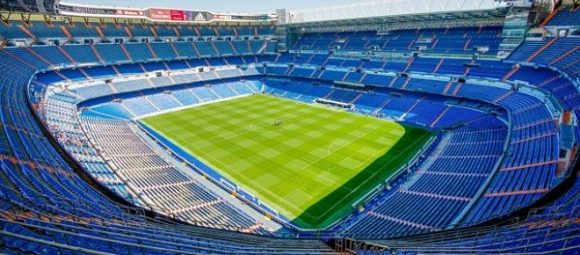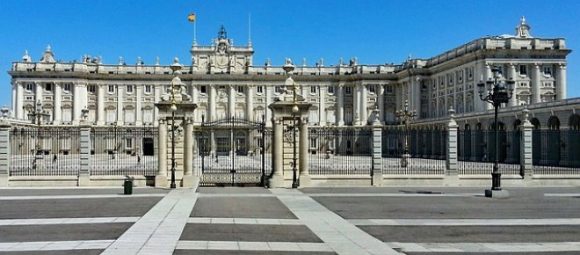Official UK partner to the Paradors, Pousadas, Pestana Hotels & Resorts, Les Collectionneurs (Chateaux), and European Hotels Collection. Keytours International, formerly Keytel International, your agent in the UK.
A Guide to Madrid
We all know Madrid as Spain’s capital, but do you know what there is to see and do in and around the city? In addition to being the economic, financial and administrative centre of the country, this vibrant, cosmopolitan city has plenty to offer tourists in terms of arts, culture and history.
We have put together some of Madrid’s key attractions and sights for you to consider on your next trip to the capital.




The Royal Palace is the official residence of the royal family and a spectacular sight to behold. The neoclassical palace dates back to the early 18th century and is built on the site of the former Royal Alcázar. The Palace has over 3,000 rooms and the highlights include the Throne Room with its painted ceiling, the Guard’s Room, the Royal Chemist’s Room with its medicine cabinets and ceramic pots and the Royal Chapel. A number of artworks by the likes of Velázquez, Goya and Sorolla grace the walls and you will also find a collection of string instruments designed by Antonio Stradivari. In addition to the grandiose building, visitors can enjoy the palace’s verdant royal gardens.
Puerta del Sol with its many shops and cafes is a very popular cosmopolitan area of the city and is home to the famous bronze Statue of the Bear and the Strawberry Tree which represents Madrid’s coat of arms. The clock tower on the south side of the square is used for the countdown to the New Year and the square fills with locals on New Year’s Eve to ring in the coming year with a party and the Spanish grape-eating tradition.
No Spanish town or city is complete without a Plaza de España and Madrid’s occupies a large space at the top of Gran Via, one of the city’s main streets. The square’s most striking feature is the large Cervantes monument and fountain which is a tribute to Don Quixote’s celebrated author.
Whilst the Plaza de España is a large square in the city, one of the most popular squares is the Plaza Mayor. It received international fame a few years ago when a former Mayor bidding for the 2020 Olympics described the square as the perfect place to enjoy a ‘relaxing café con leche’. In addition to the many cafes and restaurants nestled in the square’s arches, you can enjoy a number of street performances and take in the square’s beautiful architecture which dates back to the 17th century.
El Retiro Park is truly one of Madrid’s highlights offering a charming, green space in the heart of the city. Covering over 125 hectares, the park is home to a variety of gardens as well as a large artificial lake which is often filled with people in rowing boats. The park is a popular area with locals who will often go for a stroll through the gardens with their families and take their children to the famous puppet show on a Sunday. Sights to look out for if you visit the park include the grand Velázquez and Glass Palaces, the Fallen Angel statue (one of the few statues in the world dedicated to the devil) and the Galápagos Fountain.
Any football fans cannot afford to miss a visit to the Santiago Bernabéu Stadium which is the home ground of the Real Madrid Football Club. Opened in 1947, the stadium has a capacity of over 80,000 and is situated in the north of the city. Fans can book tickets for a tour of the stadium and museum of the club’s achievements.
When visiting Spain you probably wouldn’t expect to be transported on a journey back to Ancient Egypt, but that is exactly the effect you will experience when setting your eyes on the Temple of Debod in Madrid’s Cuartel de la Montaña Park. The temple dates back the 2nd century and is dedicated to the god Amun and goddess Isis. It was donated to Spain by Egypt in the 20th century to save the temple from the floods created by the construction of the Aswan Dam. The temple is surrounded by shallow water, and soft illumination of an evening creates a calming, peaceful atmosphere.
Like many cities in Spain, Madrid has its fair share of churches and religious buildings. The Catedral de Nuestra Señora de Almudena is Madrid’s main cathedral and is considered one of the city’s most beautiful churches. It dates back to the 19th and 20th centuries and is located next to the Royal Palace. The Gothic San Jerónimo el Real de Madrid Church dates back to the 15th century and is located next to the Retiro Park. The San Isidro Collegiate Church is the former main cathedral of Madrid and is the burial site of San Isidro, the city’s patron saint. This baroque church dates back to the 17th century and features an intricately decorated dome.
Over many centuries Madrid has been a hub for Spain’s greatest artists and literary figures, and today it is home to some of the country’s most prestigious art museums. The ‘Paseo del Arte’ is an area of the city where you can find the city’s three main art museums, the Museo del Prado, Museo Reina Sofia and the Museo Thyssen-Bornemisza (known simply as the Thyssen). The Museo del Prado celebrated its 200 year anniversary in 2019 and counts among its collection works by greats such as Velázquez, Goya, El Greco and Rubens. The Museo Reina Sofia is home to a more contemporary collection and it is here you will find Picasso’s moving Guernica painting. The Thyssen Museum collection contains a mixture of classic and contemporary pieces featuring work by artists such as Monet, Van Gogh, Degas, Gauguin, Kirchner and Mondrian to name a few. The Museum of Fine Arts (Círculo de Bellas Artes) is also located close the three big art museum and features exhibitions and live performance spaces.
Not far from the Paseo del Arte is the Barrio de las Letras (or Barrio de las Musas or Parnassus), Madrid’s literary quarter. This is an area in the centre of Madrid which was at one time home to many of Spain’s literary greats of the ‘Golden Age’ including Cervantes, Lope de Vega and Quevedo. The quarter is made up of a collection of small streets and squares such as the Plaza Santa Ana where you will find statues of poet Federico García Lorca and dramatist and poet Calderón de la Barca. As well as its literary history, the area is a popular shopping district for those looking for smaller independent shops selling a range of items including musical instruments, flamenco shoes, wines and spirits, clothing and, of course, books.
The National Museum of Archaeology occupies a grand neoclassical building along with the National Library and displays a large number of religious art and artefacts collected by Spanish monarchs over the centuries, as well as important ancient artefacts discovered throughout the country.

As with any major city, Madrid offers plenty of opportunities for shopping sprees. Calle Preciados and its surrounding areas one of the busiest shopping streets of the city and stretches between Plaza de Callao and Puerta del Sol. Here you will find a number of major high street retailers as well as one of the famous El Corte Inglés department stores.
Those looking for luxury goods should head to the Barrio de Salamanca, particularly on the Serrano and Ortega y Gasset streets where you will find high quality brands such as Gucci, Tiffany & Co, Prada and Tesla. The Salamanca district is also an excellent place to find high quality shoes.
A more rustic shopping experience and a chance to haggle can be found at the El Rastro flea market. This famous open-air market is held near the La Latina district each Sunday and on public holidays. The main thoroughfares sell clothing at very low prices, but the side streets leading off from the main market are there you will find more unusual treasures, antiques and retro goods. After picking up their wares from the market, many visitors will drop in to nearby cafés and bars for a drink and some tapas in the afternoon.
Wherever you are in the city, you will never be far from a café, restaurant or bar offering refreshments and a delicious bite to eat. Tapas bars can be found across Madrid and offer a great opportunity to sample flavours and dishes from all across Spain.
The calamari sandwich is without doubt Madrid’s favourite sandwich and you will have many opportunities to try this fried seafood specialty as it sold across the city; the streets around Plaza Mayor are particularly famous for their calamari sandwich bars.
Enjoying a café con leche of a morning is a big part of life in Spain and you can watch how the Spaniards do it places like the La Mallorquina patisserie in Puerta del Sol. The busy café has a seating area upstairs but you will find most Madrileños enjoying a coffee whilst stood at the counter.
Churros con chocolate are the staple sweet treat in Madrid after a night out on the town, and the delicious thick hot chocolate can be enjoyed throughout the day at many specialist cafés, look out for signs selling ‘Chocolate a la Taza’.
As well as lighter snacks, tapas and sweet treats, Spain has made great waves in haute cuisine over the past couple of decades and Madrid itself has a number of Michelin-starred restaurants. Fusion cuisine is the current trend, often blending Japanese and other eastern flavours with typical Spanish dishes. DiverXo is the first restaurant in 20 years in Madrid to receive 3 Michelin stars (at the time of writing) and offers up two delicious tasting menus.
Day trips from Madrid
Madrid’s location in the heart of the peninsula means that it makes a good starting point to discover other cities and towns throughout Spain. The satellite cities around Madrid are well connected with frequent train services and you can do a number of day trips from Madrid.
The Royal Monastery of San Lorenzo dates back to the 16th century and was built by King Philip II as a multipurpose complex to serve as a burial site for his father (Holy Roman Emperor Charles V) and as a monastery and palace with intricate décor. Today you can taker tours of the grand building, the lush palatial gardens and enjoy the ornate interiors worked on by the likes of artist El Greco.
Not far from El Escorial you will find a more sombre point of interest in the Valle de los Caídos (Valley of the Fallen), recognisable by the giant cross that stands at the top of the valley and can be seen from miles away. The monument and monastery were erected by Franco’s administration as a tribute to those who lost their lives during the Spanish Civil War.
Toledo, the City of Three Cultures and famous sword-producing centre, is only 35 minutes away from Madrid by train. This beautiful city has a rich and varied history, renowned for the influences of changing Jewish, Muslim and Christian populations that have inhabited the city. Surrounded by the Tagus River and its historic centre protected by ancient city wall gates, Toledo is a spectacular sight, and at its top sits the spectacular Alcázar. The Alcázar was a royal palace whose foundations date back as far as Roman occupation and was the main court Holy Roman Emperor Charles V, today it houses Castilla La-Mancha’s regional library. The city is also famous as the chosen home of painter El Greco and you can visit the El Greco house museum to learn more about the artist’s life and work.
This lovely town is the home of the Palacio Real (Royal Palace), the spring residence of Spanish royalty since the late 19th century. The palace itself dates as far back as the 18th century and is a beautiful building, but perhaps even more pleasing to the eye are the pretty royal gardens surrounding it. Each garden has its own style and name taking influences from traditional English gardens to grand Versailles-style landscaping. The fields around Aranjuez produce key Spanish ingredients such as artichokes, broad beans and asparagus.
Segovia is a city of many wonders and it can be difficult to know where to begin your historical journey. The city is perhaps most famous for the giant Roman aqueduct that runs through the centre of Segovia with its 166 arches in near-perfect condition. Dating back almost 2000 years and in use until the late 19th century, the aqueduct is an outstanding example of Roman engineering.
Not to be overshadowed is the Alcázar Fortress, whose fairy-tale like exterior is difficult to overlook. The fortress’ foundations date back as early as the 12th century and it was a royal residence before being converted to the Royal College of Artillery in the 18th century and remains so today. It is rumoured that the Alcázar was one of the inspirations behind Disney’s Cinderella castle.
This UNESCO World Heritage City is only 35 minutes from Madrid by train. Situated to the north-west of the city, Alcala is a pretty, historical city, famous as the birthplace of Miguel de Cervantes, author of Don Quixote. Today Alcalá is an important university city and its beautiful university buildings make up part of the historic centre with the lecture hall’s ornately decorated roof being of particular interest. The Casa de Cervantes Museum allows you to learn more about the celebrated writer’s life and works.
When to visit Madrid?
Madrid is a fascinating city year-round, although it can get particularly hot in summer months when will find many Madrileños escaping to the Spanish coast, so it is advisable to avoid July & August.
Madrid and its surroundings offer a great insight into typical Spanish culture and history, and we are sure you will find plenty of interesting activities to do and places to visit. Through Keytel Hotels we represent over 100 hotels in Madrid as well as Paradors in surrounding cities, perfect for a city break.
